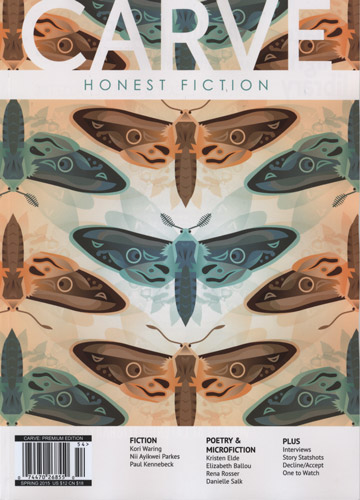Carve Magazine – Spring 2015
On the outside, Carve appears to be another waiting room read. Typically, literary reviews are thick and novel-esque. Not Carve. It’s thin (only 50 pages) and non-threatening. Cutesy, but attention-grabbing, vector art garnishes its glossy cover, embodying the literal definition of “magazine.” A rarity in form, I grabbed Carve before any other magazine in the pile. On the outside, Carve appears to be another waiting room read. Typically, literary reviews are thick and novel-esque. Not Carve. It’s thin (only 50 pages) and non-threatening. Cutesy, but attention-grabbing, vector art garnishes its glossy cover, embodying the literal definition of “magazine.” A rarity in form, I grabbed Carve before any other magazine in the pile.
What’s particularly special about Carve is not merely in the way its layout neatly organizes the magazine by genre, but in how it presents its fiction to aspiring and seasoned writers. Featured along with the writing itself is a “Story Statshot,” which includes: when the author wrote their first draft, number of drafts, number of rejections, whether or not it’s the story’s first publication, and the time from its submission to actual publication. As a writer, it allows me to put my writing into context, and it makes me feel like less of a “failure.” Aside from its statistics, following each narrative is an interview with its author. This humanizes the fiction, making it less of a mystery and more attainable.
While most might consider that these features detract from the art, I felt it embellished the writing, or at least provided a different perspective. Kori Waring, an elementary school art teacher from Pennsylvania, explains where her concept for her story “Do You Hear What I’m Saying?” originated. After reciting the plot aloud, she admits it sounds “gimmicky and schticky.” Yet, knowing her intention transforms my reading of her narrative completely. Initially, I thought the idea of children losing their voices and parrots repeating quotes from novels in the children’s lost voices was a metaphor for dead authors and writing in general. When writing it like that, it does sound rather pretentious. However, after reading Waring’s interview, I found her to be humble and her story less about dead authors wanting to live eternally through the new generation’s voices.
Nii Ayikwei Parkes’s story “The First Shampoo Show” originated around a found object in his attic. Although bits and pieces of his experiences growing up in Ghana are embedded within the narrative, it is not actually about his life. Instead, it features a story about two boys and their father trying to survive during a harsh drought while their mother is away in the UK. Parkes’s imagery and musicality are amongst some of the most notable elements: “If better days don’t come, the adults will disappear first, their shadows will swallow them, and then we will be sucked into the vacuum they leave behind.” Like myself, Parkes began writing poetry and grew up among musicians, which he later realized attributed to the fact that, “[ . . . ] almost all of my work has some element of music in it.”
The final story featured in Carve is Paul Kennebeck’s “Stratis’ Remington,” a narrative about an aging, Greek writer who gets “duped” by his neighbor, Branden, who shamelessly takes credit for Stratis’s publications after submitting Stratis’s work via his own email. Threaded throughout the story are mentions of Plato and other infamous Greek writers, and that is because Kennebeck is enamored with the culture. But if anyone remembers Plato’s teachings, he said (and I’m paraphrasing) that the best ideas are kept within one’s mind and are not to be written down. Consider that knowledge as you read through Kennebeck’s piece. It brings out the tragic irony in the story.
Another useful feature for writers in Carve’s Premium Edition is their Decline/Accept column. Here they feature a snippet from a previously declined submission, Jeannette Brown’s “Joy Ride,” as well as a longer excerpt from the accepted publication and where the reader can access the narrative in its entirety. Alongside the submissions is commentary from the editors describing why this particular piece was declined, and a note from Brown herself explaining what it meant to be rejected. In it she writes, “Although this story was not right for Carve, I lucked out when I read that Red Truck Review was looking for submissions [ . . . ]”
Although Carve focuses more on its short stories and their authors, they incorporate some of the most captivating microfiction and poetry. Of the five featured, Rena Rossner’s “Tips For Rocket Dodging” struck me the most with its hypothetical questions: “did it catch you in the shower? / in the grocery store? / at work? / in the pool? / having sex?” If you are wondering, Rossner’s poem caught me during a thunderstorm in Southern California.
Carve caters to writers as readers, to those interested in becoming published. It reminds us that editors are humans with feelings, and writers are not always writing about writing—intentionally. As readers, we can flip through the issue without being overwhelmed with 20 stories and 100 pieces of poetry, only to remember one. With Carve, each story is recallable. There is so little, but it lends so much to the humans who come across it.
[www.carvezine.com]





